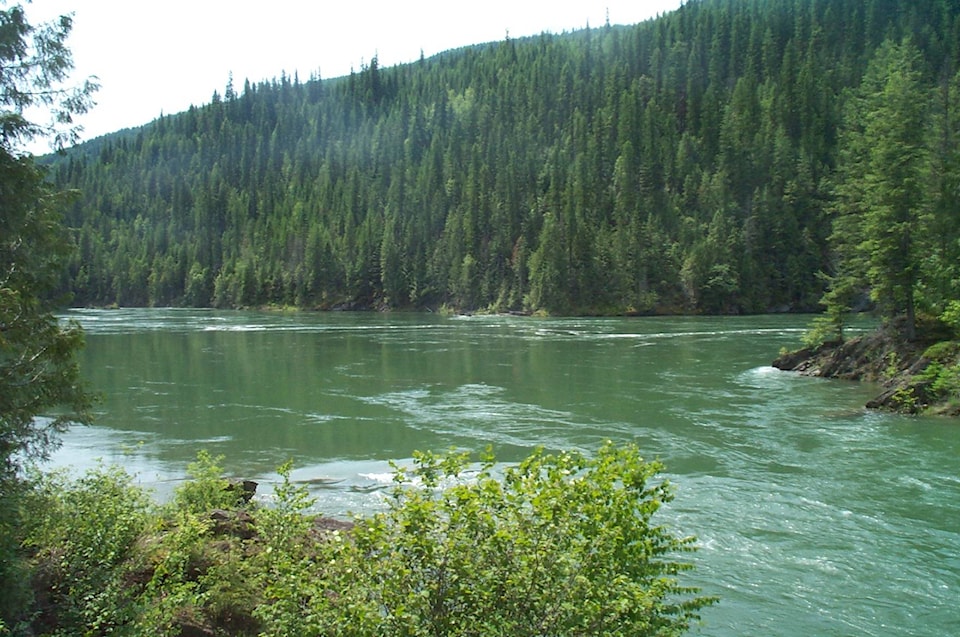Two hundred fifty-ninth in a series on West Kootenay/Boundary place names
The Pend d’Oreille River (or Pend-d’Oreille or Pend Oreille) is 209 km long but only the last 24 km flows through Canada. The river originates at Lake Pend Oreille near Sandpoint, Idaho and heads west into Pend Oreille County in northeastern Washington, then turns north, through the Colville National Forest, crosses the international border at Nelway, and loops west to join the Columbia just north of the international border at Waneta.
Pend d’Oreille is also unofficially the name of the valley between Nelway and Waneta.
The name literally means “earloop” or “hangs from ears” in French and was given by voyageurs after members of the Kalispel Tribe who wore dangling shell or bone earrings.
The earliest reference to the tribe by that name and spelling is in the Buffalo Morning Express of June 21, 1854: “On the 1st November, six Pend d’Oreille Indians came to this post [Fort Benton], and delivered up all the horses that were stolen.”
The earliest reference to the river by that name is in the New Orleans Crescent of Aug. 13, 1855: “In Oregon the gold excitement continues. On the Pend Oreille river the diggings are said to be very rich indeed.” (Oregon Territory at the time included present-day Oregon, Washington, and Idaho.)
The river has also been referred to as the lower part of the Clark Fork of the Columbia River and shows up that way on some maps, including an international boundary sheet of 1913.
However, it appeared as the Pend D’Oreille River on Joseph Trutch’s 1871 map of BC, with an upper case D. Pend d’Oreille was officially adopted as the Canadian spelling on March 6, 1913, but changed to Pend-d’Oreille with a hyphen on Nov. 3, 1932.
The 15th Report of the Geographic Board of Canada, dated March 31, 1917, said it was Pend-d’Oreille River “not Bitter Root, Clark, Deer Lodge, Hellgate, Missoula, Pend Oreille nor Silver Bow” but didn’t specify where these other names appeared.
The US spelling was initially Pend d’Oreille, as in Canada, but according to the Missoulian of June 8, 1901, the US Board on Geographic Names said “it must be Pend Oreille and gives a list of rejected forms, including Pend’Oreille, Pend’D’Oreille, Pend O’Reille, Pends Oreilles, Ponders, Ponderay, Pond Orilles, Peaux d’Oreilles and Kulluspelm.”
(Pend O’Reille, as though it was an Irish name, shows up in real estate ads beginning in 1910 and is still a common misspelling.)
So like Kootenay/Kootenai and Okanagan/Okanogon, the Pend Oreille River changes spelling when it crosses the border, becoming the Pend-d’Oreille. In 1980, the US Board on Geographic Names proposed altering the Canadian spelling to match the American one, but the Geographical Names Board of Canada said no.
Pend d’Oreille is pronounced “pon-der-ay” and a city in Bonner County, surveyed in 1904, is called Ponderay. There was also a town in southeastern Alberta called Pendant d’Oreille which is now home only to a church and cemetery.
WATERFIELD ASTEROID
Waterfield asteroid, discovered in 1933 by K. Reinmuth, is named jointly in honour of amateur astronomer Reginald Lawson Waterfield (1900-1986) and his cousin, William Francis Herschel Waterfield (1886-1933) of Crescent Bay, just south of Nakusp. William was a staff member of the Harvard Observatory in the 1920s. Herschel Creek and Waterfield Road at Crescent Bay are also named after this family.
SHERWOOD, REVISITED
Kathy Feniak fills in some details on Sherwood, a steamer landing on the east side of Lower Arrow Lake, opposite Edgewood, named by her ancestors and previously mentioned in this series.
In 1906, Walter Cyril Jowett (1878-1982) bought 100 acres of hilly, rocky land and a shack for $100. His brother William Bernard Jowett (1877-1967), who had been working on a ranch in Edgewood moved in with him and they cleared and levelled the land.
Another brother, Oswald Clair Jowett (1885-1965) arrived the following year and the three built a house known as Sherwood — so named because their parents grew up at Leeds, about 90 km from Sherwood Forest. Walter and William were also born there. Their mother Isabel’s middle name, Dale, came from Alan-a-Dale, the wandering minstrel who was one of Robin Hood’s Merry Men.
In 1909, Isabel and daughter Mary joined the brothers at Sherwood from Winnipeg, where the family originally immigrated to in 1883. Father William and another brother, Wilfrid Deiniol (1881-1982), followed in 1910.

